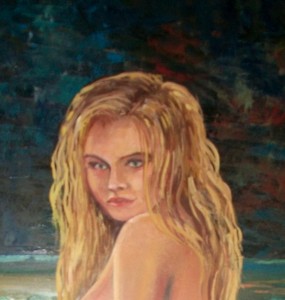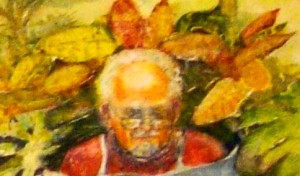
Everything has its own challenge when painting, but there is no challenge quite as unique as when painting hair. When painting hair, an artist has to consider avoiding the stringy look. They should keep the masses simple. They need to master softening the edges; and, above all, they must know how to control highlights.
Keep in mind, when edges are too hard (especially where hair meets the forehead), it will give the impression of wearing a helmet. Two areas to pay particular attention to are the hairline near the temple, and where the hair meets the neck.
When considering highlighting, it helps to remember the full mass of hair gets darker as it turns away from the highlight region. If you visualize masses of hair as ribbons, the highlight goes across, not along, the curving shape.

For demonstration purposes only
A good suggestion for water color artists is to use a dry-brush technique that can utilize the white paper (or lighter color of paint) beneath it to assist in the impression of highlighting. This can suggest a texture of the model’s hair in light. To use this technique, hold the brush handle low to the paper and gently scrumble or drag damp paint over the surface of the painting. This allows portions of white or lighter colors to show beneath the affect. Warning: Do not use to much water in your wash when using the dry-brush technique.

When it comes to painting hair, remember it has so many textures and colors that there are no recipes. An artist must practice and use their own experiences and studies to satisfy themselves. Hair might be frizzy, curly, wavy, long or short. The only advise this artist can suggest it to use the largest brush possible for the job, and keep the forms simple.
However, here is one suggestion: One way to give hair a more natural look in your painting is to lightly scrape small, squiggly, strokes when the background around the head is almost dry. If this is done with care (not overdone), it can give the impression of a few random wisps of hair along the edge of the head. When painting with watercolors, I usually use a pin for this. I know one watercolor artists that uses her long fingernail on her little finger for this. What a master she is. She does it so quick and natural…stroke, stroke.
Be sure to visit our art galleries at the top of the page.
Sign up to receive our free newsletter~it will enter your name to possibly win a free art coffee table book (only where permitted).
Check out and “like” our FaceBook Art Page (click at right side)
